14.2: The Urban/Industrial Image, 1910-30
( \newcommand{\kernel}{\mathrm{null}\,}\)
"One cannot live on a visual diet of skyscrapers and produce the same sort of art as one who is fed visually on the Acropolis"-Jacques Lipchitz (1891-1973).4
The first generation of American modernists had sought ways of expressing the internal sensations inspired by their experiences of the modern. However, their Expressionism failed to serve the needs of the following generation of modernists, who were drawn instead to a new classicism. As if wishing to lock into place the unstable energies of the city, many among the next generation of the 1920s turned to a range of styles associated with an aesthetic of restraint, balance, and immobility. They purged art of emotion. This range of response charts a mix of social meanings inspired by the freedoms, but also by the increasing rationalization and structure, of social life in the city. Blending dynamism, efficiency, and impersonal power, the skyscraper image in the 1920s and 1930s also masked the human element that propelled the new city.
From Fragmentation to Unity
The United States, where technology was reengineering culture, seemed well suited to Italian Futurism. A movement in art that glorified the machine age, Futurism attempted to capture the sensory impact of a newly mechanized environment of speed that blurred the lines between self and external world, placing "the spectator in the center of the picture," in the words of the Futurists themselves.5 Max Weber (1881- 1961) and Joseph Stella (1877- 1946) responded to the new urban environment by adapting certain formal features of Futurism. They did so by repeating forms dynamized by color and light, and by abolishing conventional perspective.

MAX WEBER. In Max Weber's Rush Hour, New York (fig. 14.12), a sense of dynamic motion is conveyed through overlapping planes and exploded forms; shapes seem mechanically repeated, as if punched out by a machine. Circles, triangles, and vectors clash with one another, while strips of windowed facades suggest the plunging perspectives of the city seen from twenty stories up. Weber's prismatic imagery recreates in two dimensions the staccato impressions and random movements of the metropolis. Rather than organizing the painting from the perspective of a privileged observer, Weber draws the viewer into it.

JOSEPH STELLA. The Futurists' ecstatic embrace of modern technology-planes, cars, subway trains, as well as machine guns and other engines of mass destruction for smashing the old order-also informed Joseph Stella's Battle of Lights, Coney Island (fig. 14.13). The painting is among the most interesting efforts to express the new urban experiences of speed, machine-driven motion, and kaleidoscopic sensations collapsing time and space. Stella was an Italian immigrant who brought to his encounter with American modernity the fervor of a convert to a new creed. His paintings of modern New York contain a range of religious symbols, from stained-glass mosaic to soaring Gothic arches. Having read Walt Whitman while still in Italy, Stella was steeped in the mythology of a new land rife with possibilities for a democratic embrace of modern life. Traveling from his home in southern Italy as a young man to join his brother in New York City, Stella was headed for a career as a doctor. Soon, however, he turned to art. Following a long period of apprenticeship, first to the Old Masters, and then to Post-Impressionism, he followed the herd of American artists to Paris. There in 1912 he met the Italian Futurists, who provided him with a language for capturing his giddy impressions of the new. These various influences came together during a trip to Coney Island, a place that combined technology, ecstatic pleasure, danger, and crowds of people-for Stella the essential elements of an art grounded in his religion of modernity. The amusement park at Coney Island transformed industrial machinery- the tracks and cars used to mine coal and transport urban crowds from place to place-into roller-coasters, the agents of a dizzying new exhilaration. In celebrating the new sensations created by the intimate dance of the machine with the human body, Stella turned to the experience of crowds, whipped up by mechanized motion and lights into a state of "carnal frenzy."6 This blend of crowds and machines is expressed in Stella's painting as a swirling motion suggesting the centrifugal force of a rollercoaster ride. Spinning out from the center, it also sucks us back in like a vortex. Anchoring the composition is the only recognizable motif in the painting-the electric tower of Luna Park in the upper center, resembling the spire of an Eastern Orthodox church. The painting is an intricate mosaic of splintered geometric patterns intermixed with organic swirls and spirals, a "dynamic arabesque," in Stella's words. In the lower register tiny human shapes pulsate in a sea of fractured forms. Abolishing all references to the humanistic perspective of his Italian heritage, Stella erases the boundaries separating the individual from his or her surroundings. Body and world become one in an experience that leaves behind both history and a sense of grounded selfhood. A carnival for men and women exhausted by industrial labor, Battle of Lights heralds an emerging culture of mass entertainment and mechanized leisure. In the experience of the modern and the loss of self, Stella found a new means of transcendence, but also the unsettling potential for alienation and a descent into frenzied unreason.
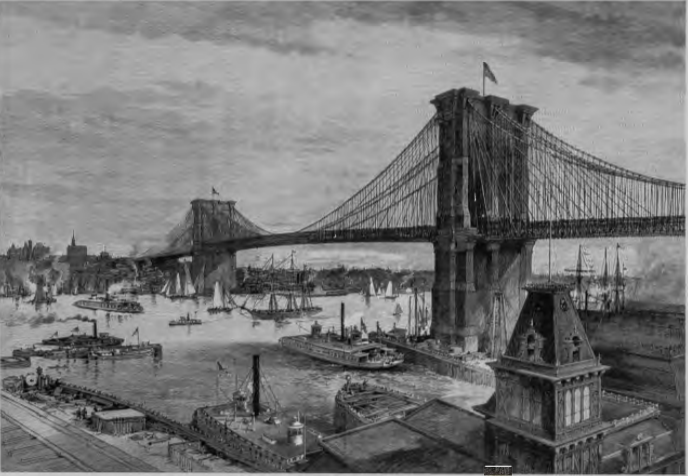
The frenetic and unsettling pace of urban life called forth a search for symbols that would connect the old century with the new. Brooklyn Bridge was one such cultural icon (fig. 14.14). The first bridge between Brooklyn and Manhattan, it helped realize the dream of a "greater" New York, incorporating the boroughs into a unified metropolis. Its design and construction, which cost many lives, became a legendary example of technical innovation and human heroism. Its massive load-bearing piers, with their gothic profiles, signified stability and strength, while its etherial steel cables, from which the roadbed was suspended, suggested modernist aspiration. For Joseph Stella as well as others, the pier and cable together epitomized an American culture that had wedded matter and spirit. The bridge, spanning old and new, past and present, pastoral Brooklyn and urban New York, became a potent symbol of the power of the modernist artist to bridge- or integrate-the divided realities of the new century.
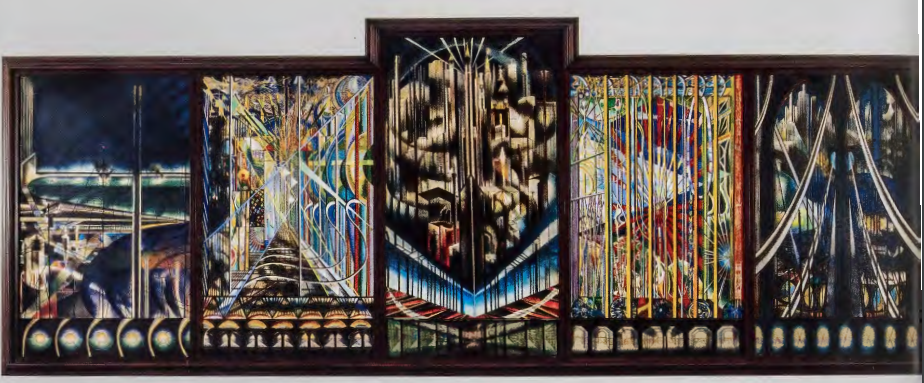
The image of the bridge appeared frequently in the arts and poetry of the 1920s, a decade when the initial exuberance of the first phase of modernism gave way to a desire for historical and cultural anchors. The bridge holds a key place in Stella's 1920-2 five-paneled Voice of the City of New York Interpreted (fig. 14.15). Here he has tamed the wild impulses of his Coney Island, transforming his splintered shards of colored light into a grand hymn of exaltation to the new America. Voice of the City used the polyptych, a form associated with the religious altarpiece, complete with smaller panels below the main canvases. In contrast to Battle of Lights, Voice of the City is a work of integration in which the fragmented, disorienting metropolis achieves a monumental new stability, anchored symbolically by the stone piers of the bridge itself. Four panels are symmetrically disposed on either side of a larger central panel, rising in a kind of crescendo from the outer reaches of the metropolis-the New York port and the Brooklyn Bridge approach to Manhattan-to two decorative panels of the Great White Way, culminating in the central New York skyline. The title Voice of the City recalls the origins of the term "vaudeville" in the French voix de ville, or voice of the city. And like vaudeville, Stella's polyptych is a performance in several acts. Each panel steps forward to present a different face, while forming one part in a larger unity. Speaking in many accents, vaudeville-like Stella's painting-condensed the variety, excitement, and polyphonal richness of the new city into manageable forms.
Perhaps more than any other artist of early American modernism, Stella expressed, with an immigrant's deep conviction, the sense of spiritual and social liberation offered by the new American city-a liberation from history as well as from inherited forms. Movement away from his European past allowed Stella, in his own words, to find "the green freedom of my own self."7
Precisionism: Modernist Classicism and the Aesthetics of Immobility
"It was clearly the problem of the modern painter to purge himself of all individualistic tendencies .... He should devote himself to the cause of purity and precision"-Peter Blume.8
Precisionism, which stabilized and ordered the anarchic energies seen in Stella's Battle of Lights, was a form of modernist classicism. Applied to machinery, to industrial architecture, and to tall buildings and urban skylines, Precisionism evacuated the human presence to emphasize the remote, impersonal appeal of pristine geometries. Yet these very qualities-remoteness, cool impersonality- suggest an undercurrent of ambivalence; erasing the human presence also erased the liveliness of variety and mobility.
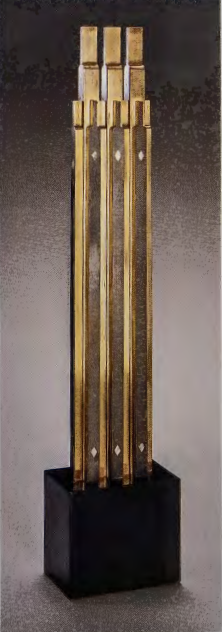
Precisionism in the United States was part of an international reaction against Expressionism in art. In Germany it took the form of the Neue Sachlichkeit or New Objectivity, in France, of "Purism." These various movements shared a desire for clarity, stripping away fuzzy emotionalism and expressive brushwork. Impersonality and austere handling were now desired qualities. Characteristics associated with the machine-functionality, impassiveness, formal precision -were extended to image-making. The search for classical poise reinforced a related impulse toward objective form, which was coupled with a tight, airless rendering in which all accidents of vision were purged. In sculpture, the Precisionist impulse found expression in the elegant monoliths of John Storrs (1885- 1956), whose staggered profiles refer to the setback skyscrapers from the 1910s forward (fig. 14.16).
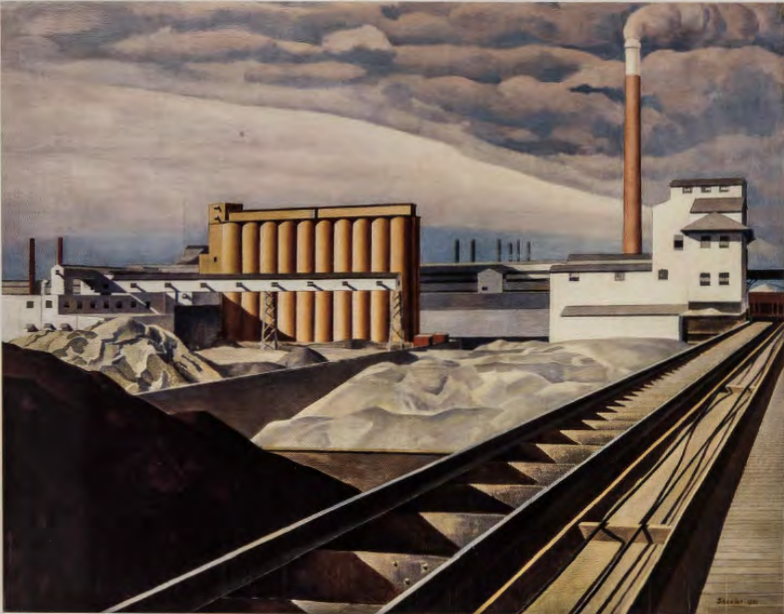
CHARLES SHEELER. The classicizing impulse was also linked to older art. Precisionists Charles Sheeler (1883- 1965), Morton Scharnberg (1881- 1918), and Elsie Driggs (1898-1992) were among those artists deeply impressed with such early Italian Renaissance masters as Giotto, Masaccio, and Piero della Francesca. Such inspiration offered a way of redeeming modern subject matter through historical associations with the monumental art of the past. Sheeler' s Classic Landscape (fig. 14.17) associates the industrial present with the stability and harmony of classical aesthetics. Sheeler much admired the art of the Greeks, who represented for him an ideal balance between the human and the natural. Applied to the complex interlocking industrial landscape of the Ford plant, Sheeler's title and ordered composition suggest an effort to find heroic order and balance in the operations of a factory. At River Rouge, all facets of the industrial process were controlled by Ford, from the supply of raw materials (the Ford empire included rubber plants in Brazil, ore mines in Michigan, and coal mines in Appalachia) to their transportation and processing. In the background are the mountains of iron ore, limestone, and coke used to make iron, the main ingredient in steel manufacturing. In his representational strategy Sheeler differs from other painters of machine-age America in showing the manufacturing process as a sequence from raw materials ( extraction) to processing to parts production, to assembly, rather than isolating machines from their industrial context. In doing so, he restores a narrative to the subject of industry. However, by banishing the human element, he avoids the social conflicts that attended Ford's industrial monopoly in Detroit. In place of the fractured plans and exploded perspectives of works from the 1910s, with their spatial discontinuities, Sheeler's Classic Landscape restores industry to temporal continuity, physical integrity, and harmonious balance.

Commissioned by the founder to create a series of views of his factory, Sheeler was sarcastically dubbed the "Raphael of the Fords." While he did occasionally betray some ambivalence toward American industry, in Crisscrossed Conveyors, River Rouge Plant, Ford Motor Company (fig. 14.18) Sheeler nevertheless created his most reverential image. Slightly off-center, crossed diagonal conveyor belts are anchored by the staccato verticals of the smokestacks; the viewer's gaze is upward, as if in religious contemplation. "It may be true," Sheeler wrote, "that our factories are our substitute for religious expression."9 Judging from the number of times Crisscrossed Conveyors was reproduced, it clearly struck a chord with business leaders looking to exalt the image of industry.

"TOMBSTONES OF CAPITALISM." Certain artists such as Stefan Hirsch (1899-1964), Francis Criss (19m-73), George Ault (1891-1948), and Peter Blume (1906-92) employed the visual rhetoric of Precisionism in a more direct indictment· of the very structures of industry and capital that their dean-edged and rationalized style appeared to emulate. Ault's From Brooklyn Heights (fig. 14.19) transforms the soaring skyscrapers of lower Manhattan into brooding, oppressive gray monoliths, "tombstones of capitalism," in the words of the artist, inverting their celebratory description as "cathedrals of commerce."10 Seen from across the East River, they are reduced to stark volumes softened only by plumes of smoke. Hirsch-in a similar veinwrote that his 1921 painting of Manhattan "expressed my recoil from the monstrosity that industrial life had become in 'megapolitania."' In this instance, Precisionism was turned against itself, its pristine geometries and airless clarity expressing the dehumanizing scale and inhuman might of capitalism allied to industry.
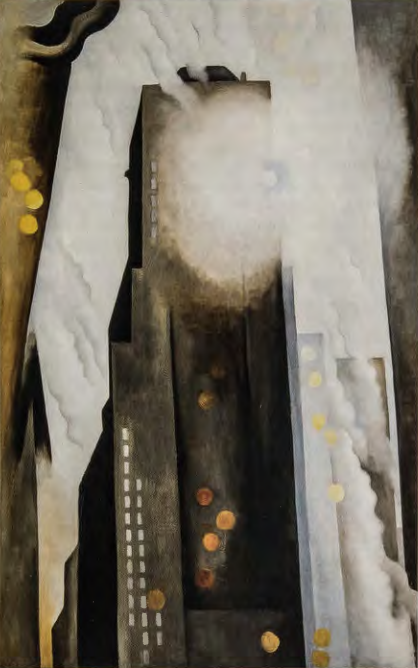
Georgia O'Keeffe (1887- 1986) also complicated Precisionism with her own nature-based language. Between 1925 and 1930 O'Keeffe completed over twenty paintings featuring the skyscraper city. These represented a major shift in subject matter for the artist. By this time the leading American female modernist, O'Keeffe was associated with the feminine subjects of still-life and landscape. Her turn to the skyscraper-associated with the masculine spheres of business and technology-troubled her critics, who were willing to acknowledge her modernism as long as it safely pertained to a traditional subject matter linked to her "feminine nature." From O'Keeffe's perspective, however, urban subjects offered new challenges. Always interested in the form-defining properties of space, O'Keeffe used the urban landscape to invert the emphasis of male Precisionist painters on hard-edged mass and volume. Paintings in the series give equal visual weight to the spaces between the massive towers of the city. For O'Keeffe, painting the city in terms of canyons, spatial voids, sky, sun, and moon gave to this modern subject an American twist by associating it with the grand scale of the American landscape. She redefined the urban theme by bringing nature back into the city. Mass is dematerialized in the light of the sun, in her The Shelton with Sunspots, New York (fig. 14.20). She noted later that as she started to work, "there was the optical illusion of a bite out of one side of the tower made by the sun. . .. "11 Ridged clouds cascade down, animating the spaces between the buildings. Nature vies for power with the city.


